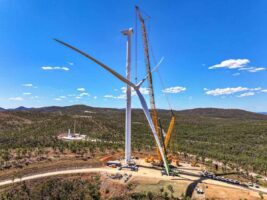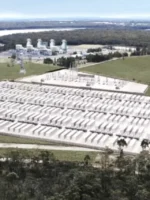Western Australia has secured $3 billion in federal funds to build out new transmission projects to support the stunning renewable energy plans of its mining giants in the north of the state and by green industries in the south.
The deal between the federal and state Labor governments – signed by prime minister Anthony Albanese and premier Roger Cook in Perth on Tuesday – has been described as a landmark agreement.
The funds, part of the federal government’s $20 billion Rewiring the Nation program which is being funnelled through the Clean Energy Finance Corp, will seek to boost the state’s main grid in the south, and the north-west grid in the Pilbara, where the huge iron ore mines are seeking a path to zero emissions power.
It follows the release of a report earlier this year by the state government that identifies demand for more than 50 gigawatts (GW) of new wind and solar capacity to meet the surging demand from green hydrogen and green industrial needs.
See: WA plans huge switch to solar and storage as part of stunning 50GW green energy boom
It also follows an agreement from the country’s big iron ore miners to end their “feudal” system of individual grids in the Pilbara to create a massive green energy hub to power their mines and deliver on global demands for zero emissions supplies.
See: Mining giants agree to end feudal energy grids and create massive renewables hub
The CEFC money will be delivered in the form of concessional loans and equity investments, and will apply new builds and major upgrades to transmission in the main South West Interconnected System (SWIS) and the North West Interconnected System (NWIS).
State energy minister Bill Johnston said most of the money would likely to allocated to the Pilbara, with some for the SWIS – particularly around the Kwinana area – and for the Mid-West region north of Perth where numerous green hydrogen projects are being proposed, and strengthening the grid in the Goldfields region.
“Initial modelling suggests that in 20 years’ time, the SWIS grid will need to have up to five times more electricity than is available today, as new industrial users connect to the grid,” a joint statement said.
“The Pilbara’s NWIS consists of largely standalone networks owned by private companies and public entities, with only a very small proportion (less than two per cent) of electricity generated from renewables.”

Albanese, who visited the Pilbara last week – where we was criticised for wearing a Rio Tinto sponsored hi-viz shirt – said the demand for renewables was significant.
“On the weekend I visited Karratha and saw first hand the economic power of the Pilbara – as the global economy decarbonises we need to provide opportunities for regions like the Pilbara to be powered by as much renewable energy as possible,” he said in a statement.
Later, in a radio interview, he added: “We need to upgrade the grid so that renewables can fit into the grid, simply. Our energy grids were built for a time where solar panels were things on pocket calculators, not powering households and industries.”
WA’s renewable industry has been limited by the lack of capacity on the local grid, which is the world’s most isolated grid of its size, suffering huge amounts of curtailment and struggling to get connection approvals.
“In WA we are delivering on our sensible and achievable plan to decarbonise our existing industries, and create new clean energy industries as we transition to net zero, unlocking new projects while supporting new and ongoing local jobs,” Cook said in a statement.
“This significant package means we can accelerate the development of key energy transmission projects to facilitate decarbonisation, while also building on my Government’s climate action plan and initiatives already underway towards more secure, cleaner, reliable and affordable energy supplies.”
Johnston said he expected “tens of billions” of dollar to be spent on renewable energy generation and transmission infrastructure in coming decades.
“The low-cost finance program will help unlock this significant investment,” he said. “Keeping Western Power in public hands has allowed the State Government to support this significant program of works by funding transmission infrastructure in the SWIS.”










